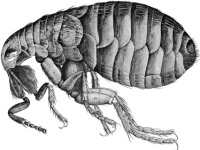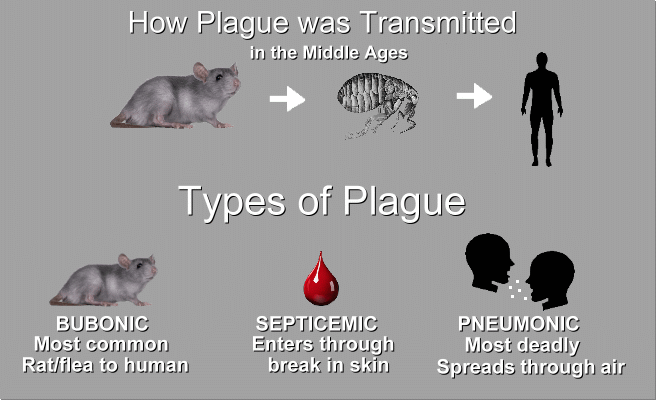 Plague is an illness caused by the Yersinia pestis bacterium. The most common form, bubonic plague, comes from flea bites, but you can get pneumonic plague from someone who’s infected. Plague caused deadly pandemics in the past and still exists in many countries today. You can survive plague if you’re treated with antibiotics quickly.  The so-called 'Black Death' killed between 25 million and 50 million people in Europe during the 14th century. This was about 30% to 50% of Europe's population at the time. starting in 1348 when the plague reached London. The pandemic moved fast; it often killed a host within days of their first developing the high fever, the telltale rash, and the repellent buboes or swellings in the armpits and groin, which turned black and burst, expelling pus and bacteria. The disease spread through families, houses, villages, towns, and cities with terrifying speed and a high death rate. Hunger and poor sanitation made people vulnerable to sickness, and it spread to different countries through trade routes. Carts were used to transport the dead from the city to communal pits for burial. Many people use medieval artwork to show bubonic plague, but the people in the artwork are usually shown with sores all over. This isn't what plague looks like. The iconic artwork likely shows smallpox or leprosy.
The so-called 'Black Death' killed between 25 million and 50 million people in Europe during the 14th century. This was about 30% to 50% of Europe's population at the time. starting in 1348 when the plague reached London. The pandemic moved fast; it often killed a host within days of their first developing the high fever, the telltale rash, and the repellent buboes or swellings in the armpits and groin, which turned black and burst, expelling pus and bacteria. The disease spread through families, houses, villages, towns, and cities with terrifying speed and a high death rate. Hunger and poor sanitation made people vulnerable to sickness, and it spread to different countries through trade routes. Carts were used to transport the dead from the city to communal pits for burial. Many people use medieval artwork to show bubonic plague, but the people in the artwork are usually shown with sores all over. This isn't what plague looks like. The iconic artwork likely shows smallpox or leprosy.
Plague still exists. It’s most common in parts of Africa, but a few cases are reported in Asia, South America and the U.S. every year. Worldwide, 1,000 to 2,000 people are diagnosed with plague every year; only about seven cases are reported in the U.S. It is cured with antibiotics, if treatment starts early.  Plague is a zoonotic disease, which means you can get it from animals and they can get it from you. This disease usually spreads through bites from fleas that previously bit an infected animal. Today we still use the word “plague” to mean illness caused by Yersinia pestis. Usually, we also call it by the specific type of plague it is — bubonic, septicemic or pneumonic, the three types of plague.
Plague is a zoonotic disease, which means you can get it from animals and they can get it from you. This disease usually spreads through bites from fleas that previously bit an infected animal. Today we still use the word “plague” to mean illness caused by Yersinia pestis. Usually, we also call it by the specific type of plague it is — bubonic, septicemic or pneumonic, the three types of plague.
Which type you have depends on where in your body Y. pestis ends up. Bubonic plague infects your lymph nodes, septicemic plague is in your blood and pneumonic plague affects your lungs. Bubonic plague Bubonic plague is the most common form of plague. It’s also the most survivable. With quick antibiotic treatment, you have about a 95% chance of recovering from bubonic plague. Bubonic plague makes one or more lymph nodes painful and swollen. The affected lymph nodes are usually near where an infected flea bit you. Septicemic plague When Y. pestis gets into your blood, you have septicemic plague. It destroys your tissues, leading to gangrene and organ failure. Your fingers, hands, toes, feet or other body parts might turn black. You can get septicemic plague from: Pneumonic plague You get pneumonic plague when Y. pestis bacteria gets into your lungs. It’s the least common but most dangerous type of plague. Pneumonic plague can spread from person to person through coughing and sneezing, just like the common cold. You can also get it from close contact with infected animals or from bacteria moving to your lungs from another part of your body (a secondary infection). Pneumonic plague causes severe pneumonia and respiratory failure. If not treated, most people with pneumonic plague die within days. When Y. pestis enters your body, it hides from your immune system, allowing it to multiply and spread. When it gets into cells, it releases a toxin to kill the cell. Y. pestis can infect your lymph nodes (bubonic plague), causing large swellings called buboes. If it gets in your blood (septicemic plague), it can damage your organs. If it gets into your lungs (pneumonic plague), it can cause severe inflammation and respiratory failure.  Most people think of rats as the only carriers of plague, but many animals carry and spread the disease. Which animals are more likely to have plague is different depending on where you live. Research shows plague can affect: Bubonic and septicemic plague are not contagious, but pneumonic plague is. Pneumonic plague can spread from person to person through coughing, sneezing and close contact.  Isaac Newton was forced to leave Cambridge during the Great Plague of London in 1665, and returned to his family's farm in Woolsthorpe. This time became known as his "year of wonders" because of the groundbreaking discoveries he made while there:
Isaac Newton was forced to leave Cambridge during the Great Plague of London in 1665, and returned to his family's farm in Woolsthorpe. This time became known as his "year of wonders" because of the groundbreaking discoveries he made while there:
|